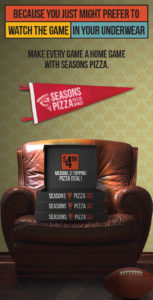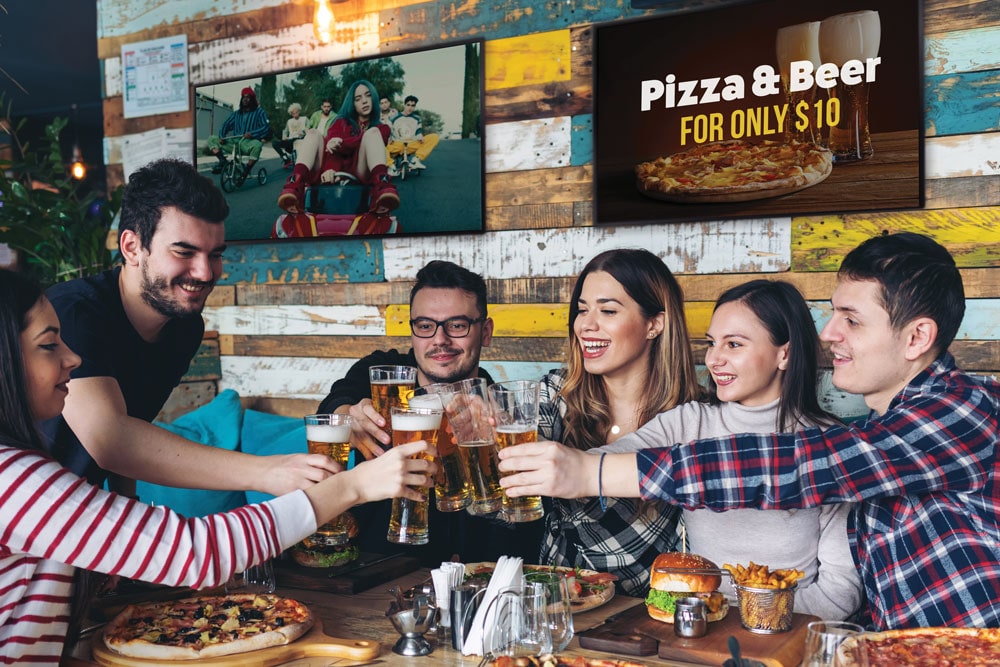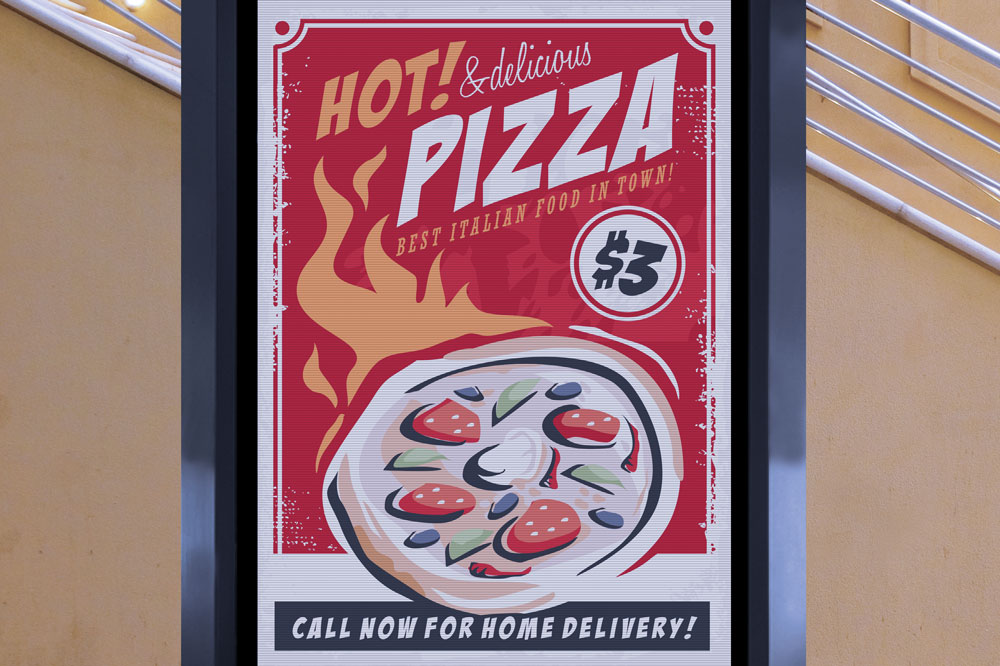From smartwatches to cell phones, it seems that all people do nowadays is gaze at screens—so why not claim your own slice of exposure via digital restaurant signage? After all, today’s information-overloaded customers have come to expect an onslaught of dynamic graphics, and motionless signs may not be cutting through the clutter. “Standard signage simply does not have the same effect,” says Patricia Walterick, marketing director of New York City Signs and Awnings, based in New York. “Digital signage demands attention, and people better remember what was being promoted. Neuroscientists studying the effects of various marketing methods have concluded that our brains often turn off the information presented to us, because there’s so much of it. In a sea of static signs, a digital sign is the one that isn’t ignored by our brains, simply because it’s a moving image with lights that attract our eyes.”
Why Go Digital?
In addition to its attention-grabbing nature, digital restaurant signage offers multiple benefits to operators. Going digital requires an up-front investment, but operators can enjoy savings over the long haul, notes Wayne Rasor, director of digital and exterior technology for Fastsigns International in Carrollton, Texas. “Owners will see savings in marketing and printing costs, as content can be updated in real time as inventory and demand change, whereas printed signage takes time to create,” Rasor says. “Additionally, remote and network management of content allows for brands with multiple locations to quickly and easily update signage with scheduled accuracy.”

Use digital restaurant signage to promote ongoing events like football-season special deals so that customers will think of you on game day.
Then, of course, there’s the bottom-line boost, outlined by Darren Easton, vice president and creative director at Crofton, Maryland-based The Cyphers Agency. Indoor and outdoor digital signs can help encourage impulse buys; create habitual consumers by displaying daily or real-time specials; or capture new customers (or increase the purchasing frequency of current customers) by introducing or promoting new menu items. “This form of media simply saves customers a great deal of interaction time,” Easton explains. “Digital signage not only efficiently conveys information to customers, but also eliminates the need for a customer to hear, and an employee to deliver, what is often a time-consuming explanation of and instructions for ordering an item or special.” Hence, employees have more time to truly engage and provide higher customer satisfaction, thereby encouraging loyalty.
On the other hand, digital signs can also do their part to connect with customers. “Digital signage is another means of telling your brand story, informing customers of your culture and vibe,” says Adam Melrose, senior business development executive for Control Play in London, Ontario, Canada. “Whether it’s an ad for a daily special, an event promotion, or sharing your social media pages, everything you display should have a strong sense of branding that people can immediately recognize. Having guests clearly remember your brand helps cement your venue as their go-to spot for a night out or a great meal—and these recurring visits make a huge impact on your bottom line.”
“In a sea of static signs, a digital sign is the one that isn’t ignored by our brains, simply because it’s a moving image with lights that attract our eyes.”
— Patricia Walterick, New York City Signs and Awnings
Sign Language
Putting digital restaurant signage in place is half the battle—now it’s time to make the most of your investment. Deeana Radley, business and technology writer for Technology Evaluation Centers in Montreal, lists some key features to keep in mind:
- Content scheduling: Owners can schedule digital menus to change automatically (i.e., for lunch and dinner).
- Multiscreen support: Video display walls are a great way to artistically attract the eyes of hungry diners. You can display screens in unusual shapes and use multimonitor controls to dynamically display ads.
- Media library: Some signage software comes with a library of media images, which can save money on stock images or hiring photographers.
However, pizzerias that already handle their own photography will certainly have a leg up when it comes to digital signage. “The rule of thumb for print signage applies equally to digital: Quality content wins the day,” notes Mark Marth, president of New York-based Coloredge. “Working with the best digital sign distributor won’t matter if your images, text and design aren’t great—so it’s worth investing a little to make sure the content you’re displaying on your digital signage is attractive, eye-catching, clear and dynamic.” And, Marth recommends, digital signage is also great for engaging with your customers and collecting information. Whether you’re promoting your social feeds or setting up a touchscreen system that allows customers to register for rewards, use the medium to draw customers in and learn more about them.

Operators can choose to use TVs already in-house to show entertainment, such as music videos, alongside ads for specials or promotions. Photo courtesy Control Play.
Rasor agrees that the operator’s focus should be on creative content, using animation and motion to help break through the noise and attract customers’ attention—for example, to help promote higher-margin products. Meanwhile, Walterick suggests promoting upcoming events (think Super Bowl Sunday or local happenings around town) for days or weeks in advance using digital signs. “Use the sign to highlight the event and promote any specials you might be running for it,” Walterick says. “This allows people to have the image ingrained long before the event occurs, so they’ll remember that pizza-and-wing special on game day.”
Related: Three tips for maximizing pizza sales through digital restaurant signage
If your pizzeria already houses TVs, you can also integrate digital restaurant signage with in-house entertainment (for example, playing music videos), Melrose adds. “Ads for menu items and specials are probably the most common displays, but there’s a lot more you can promote, like sharing your social media info, letting people know how and why to follow you while they’re still in your venue,” he says. “For selling high-margin items, digital signage ads show people exactly what they’re paying for—a high-res image of delicious food is incredibly hard to ignore, and customers will gladly pay a little bit more to satisfy their cravings.”
Still attached to your “old-school” static signs? You needn’t ditch them completely, according to Marth. “When you completely rely on digital signage for everything, if you have tech or device issues, your signage is gone!” he notes. “Digital and print signage complement one another, so businesses should make good use of both. Digital signage can lend a vibrancy and interactivity that print signage alone can’t achieve.”
Tracy Morin is PMQ’s senior copy editor.
Takeaway Tips
Darren Easton, vice president and creative director at The Cyphers Agency in Crofton, Maryland, has created digital campaigns for Mid-Atlantic chain Seasons Pizza and shares his four top tips for making the most of digital restaurant signage:
-
Change the information on your sign frequently, ideally every day. This protects against the sign fading into the landscape for frequent consumers and also delivers the message that your brand is active and energetic.
-
Make the messages or ads as “real-time” as possible. Keep content current—focusing on the daily special, lunchtime promo, holiday or season, new menu items, etc., and supporting it through real-time social media posts featuring high-quality images of the food items on your signage.
-
Integrate your signs’ content with your campaigns. If you’re running an ongoing game-day special during football season, for example, customers who are already engaged with the campaign on your social media channels will expect to see campaign elements on your outdoor or in-store signage, while those who are not yet engaged can be driven to become members of your online community.
-
Tap social media. Use signage to encourage customers to use Facebook’s check-in or Instagram’s location-tagging features. For example, offer a discount or free item when they check in to your location. When they do so, it helps create a sense of “missing out” among their own followers. Your sign can also support ongoing or event-focused engagement on Twitter, whether through a branded hashtag (i.e., #EatSeasons), promotion- or item-specific hashtag (#BOGOSaladWednesdays), or a hashtag tied to a current event (#NationalPizzaDay).













